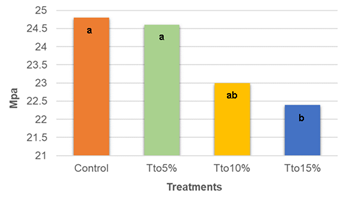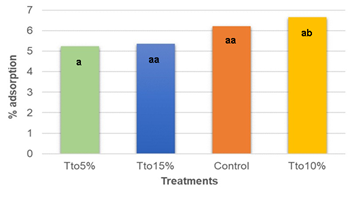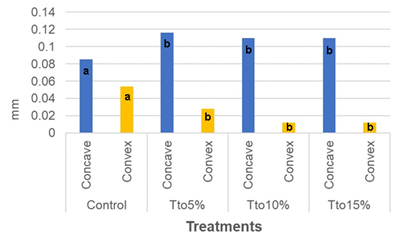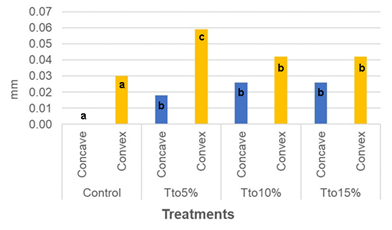I. INTRODUCTION
Circular economy is a key proposal in the rational use of natural resources, which is beginning to have relevance in the construction industry to reduce its environmental impacts [1]. Sustainability plays an important role, especially when hazardous waste is used with green technologies [2]. Globally, large amounts of agricultural waste are produced, including rice husk, a waste that is burned causing serious environmental pollution [7, 3]. However, this biomass can be converted into raw material to increase its value and reduce its environmental impact [84, 95]. Currently, the demand for construction inputs and materials has increased considerably [3, 6-4, 7], which has generated the need to convert waste into useful building materials such as bricks, used in construction worldwide due to their strength, durability, load bearing, compactness, and light weight [5, 8-6, 9].
In this regard, the study of agricultural and industrial wastes (sugarcane bagasse ash and rice straw ash) as an alternative to cement, fine aggregate, coarse aggregate, and reinforcement materials in the construction sector is gaining importance [10]. The use of wastes with pozzolanic behaviors have currently become the main partial replacements of cement [11], so they are being used as construction material; among them we find fly ash, silica fume, rice ash, among others. Evidencing an increase in their use in the construction industry [12, 7], which can lead to the development of cheap and durable construction materials [13]. However, despite the knowledge of its pozzolanic properties, a large amount of rice husk ash is disposed of, causing negative impacts on the environment [14].
According to [15], in Peru, paddy rice production in 2020 was 249,951 thousand tons, with the Lambayeque region contributing 428,285 tons that represent 77,091.3 tons of rice husks (18%). Studies [16, 13, 17, 18] have shown that rice husks contain about 85 to 95% amorphous silica resulting from the sublimation of organic compounds, which makes it a good cementitious material thanks to its behavior and high pozzolanic reactivity, classifying it as class N pozzolan according to ASTM C618. However, these chemical characteristics differ according to the type of rice, harvesting period, soil and climatic conditions. On the other hand, some researchers have concluded that the pozzolanic reactivity of rice husk ash depends on silica content, fineness, available alkaline media, the crystallization phase of the silica, and the size and surface area of the ash particles, as well as the incineration technique, temperature and combustion time, factors related to silica dissolution and aimed at obtaining an ash containing a small amount of carbon [19, 12, 18]. Thus, it has been reported that the fine particle of rice husk has a greater pozzolanic action and resistance when used partially with cement [20].
II. METHODS
The procedures defined for obtaining the results were the following:
A. Experiment Design
The experiment was carried out with an absolute control (standard concrete brick) and three treatments with different concentrations of calcined rice husk ash addition (5%, 10% and 15%), each treatment had ten replicates, a number that allowed a reliable average value to be obtained, the bricks obtained were type 17 (brick for general use where moderate compressive strength and resistance to the action of cold and moisture penetration is required). The tests were performed according to the procedures and minimum and maximum values established in NTP 399.601 for concrete bricks [21].
B. Gravimetric Method for the Determination of Silicon Oxide
In a crucible, a sample of 0.5 g of rice husk ash was weighed and 4 g of sodium carbonate were added. It was mixed with a glass rod, then it was covered and taken to a burner for 10 minutes until it was completely mixed. Once the mixed sample was cooled, it was transferred to a 600 ml beaker and 20 ml of HCl 1:1 were added. It was brought to heating until completely dry. Then 15 ml of 1:1 HCl and 30 ml of hot water were added, then it was taken to the heating plate until boiling point. Subsequently, it was filtered on hot Whatman n°42 paper and washed 7 times with hot water. The filters were placed on the previously weighed platinum crucibles, dried in the oven at 80 °C for 2 h and taken to the plate at 350 °C for combustion. They were placed in the muffle at 900 °C for one hour, then placed in a desiccator for 12 h, and weighed on an analytical balance to obtain the SiO2 weight. The following formula was used to determine the percentage of SiO2:
C. Compressive Strength Test
The test was carried out on dry samples with length, width, and heights equivalent to those of the control (242 mm, 133 mm, and 82 mm), approximately. The resistance capacity of each sample was considered, taking into account the relationship between the compressive breaking load of a brick and its gross section, the values obtained were compared with the nominal compressive strength value established in NTP - 399.601. The test samples considered for work had as characteristics almost flat and parallel ends without chips or cracks. Five replicates were taken per treatment (20 samples in total).
The test was performed on the largest dimension of the brick, placing them on the center of the upper spherical support with a margin of 2 mm. The upper support was a hardened metal block, spherically and firmly seated in the center of the upper machine head (ball and socket joint). The center of the ball joint was aligned with the center of the surface of the block in contact with the specimen, having a perimeter of at least 6 mm head free. The diameter of the contact surface was at least 130 mm.
The surfaces of the support block intended to contact the specimens had a hardness of not less than 60 HRC (HB620). These surfaces were flat with a tolerance of 0.03 mm. In order for the contact area of the spherically supported blocks to be sufficient to cover the area of the specimen, a steel plate with a flattened surface, a tolerance of 0.03 mm and with thickness equal to 1/3 of the distance from the end of the spherical support to the most distant corner between the spherically supported block and the specimen with cover was placed. These plates were of the same quality - 60 HCR - and had a length and width of 15 mm. The load was applied up to half of the maximum expected load with an appropriate speed. The compressive strength was calculated using the equation given below, the results obtained had an approximation of 0.01 MPa.
Where C is Compressive strength, MPa; W is Maximum load in Newton (N), indicated by the testing machine; A is Average gross area of the upper and lower contact surfaces of the specimen.
D. Absorption Test
A balance with a capacity of not less than 2000 g and an approximation of 0.5 g was used to determine the weight. Five replicates were made per treatment (20 samples in total). The samples were immersed in clean distilled water at a temperature of 22 °C for 5 hours, after which they were removed from water, cleaned, and dried after 5 minutes. The absorption percentage of each sample was calculated with the equation (3).
Where Ws is Dry weight of the sample, Wd is Weight of the saturated sample after immersion in cold water.
E. Warpage Test
For the warpage test, a steel rod with a straight edge, a graduated steel ruler with 1 mm divisions, a flat steel surface no smaller than 300 mm x 300 mm, and flat within a range of 0.025 mm were used. For this test, 10 replicates were performed per treatment (40 samples in total). Both concave and convex surfaces and edges were evaluated.
1) Concave Surfaces. The straight-edged rod was placed longitudinally along the surface of the sample to be measured, adopting the location that gives the greatest deviation from the straight line. The greatest distance from the surface of the sample to the straight-edged rod was chosen. Using the ruler, the distance was measured to the nearest 1 mm and the concave distortion of the surface was recorded.
2) Convex Surfaces. The convex surface of the specimen was placed in contact with the flat steel surface and with the corners equidistant to the flat surface. With the ruler, the space was measured to the nearest 1 mm at each of the 4 corners of the flat surface. The average of the 4 measurements was recorded as the convex distortion in each of the samples.
3) Concave and Convex Edges. The rod was placed between the ends of the edges (concave or convex) to be measured. The greatest distance from the edge of the specimen to the rod was chosen. With the ruler, the distance was recorded to the nearest 1 mm and the concave and/or convex distortion of the edge of each sample was noted.
III. RESULTS
This section shows the results achieved with the procedures performed.
A. Silicon Oxide (SiO 2 ) Content of Rice Husk Ash
The ashes obtained showed percentages of silicon oxide content between 78.39 - 80.47%, which shows that the content of this compound in the rice husk varies, however, according to the Tukey test (p<0.05) there was no significant difference for the SiO2 content test.
B. Compression Test
The results obtained in the compression test showed that the percentage of calcined rice husk ash addition affected the strength of the brick, showing that the higher the ash concentration, the lower the compressive strength (MPa). On the other hand, in the Tukey test (p<0.05), it was shown that there was a significant difference between the treatments under study in order to compare the compressive strength of the bricks; however, the control (standard brick) and the Tto 5% showed to be statistically similar with average values of compressive strength of 24 Mpa. On the other hand, the Tto 10% and Tto 15% treatments showed the lowest resistance values with 23.0 and 22.4 MPa, respectively. However, the values obtained for the treatments exceeded the minimum compressive strength values established by the NTP 399.601 for type 17 bricks, which is 14 MPa.
C. Absorption
The results of the absorption test showed that the percentage of calcined rice husk ash concentration did have an effect on the absorption capacity of the treatments under study, in that sense, to compare the average percentages of the absorption capacity, the Tukey test (p<0.05) showed that among the treatments under study there was a significant difference, being the Tto 5% the treatment that showed the lowest percentage of absorption with 5.24%, followed by the Tto 15% treatment with 5.36%, compared to the control (standard brick) which showed 6.22%, also, both treatments proved to be statistically similar. On the other hand the Tto 10% treatment showed the highest percentage of absorption with 6.66%, it should be noted that the absorption values obtained were below those established in the NTP for type 17 bricks, which is 10%.
D. Warpage
1) Upper Side. The results obtained from the measurement made on the upper face of the bricks according to the concentrations of rice husk ash to determine its concavity and convexity, showed that the control had the lowest level of concavity with an average of 0.085 mm, however, the level of convexity had the highest value with 0.054 mm compared to the other treatments. On the other hand, the treatments (5%, 10% and 15%) according to Tukey's test (p<0.05) in both measurements showed statistically similar values with an average of 0.116 mm and 0.110 mm for concavity, and 0.028 mm and 0.012 mm for convexity, respectively.
2) Lower Side. The results obtained from the measurement of the warpage on the lower side of the bricks showed that the control presented the lowest average values compared to the other treatments under study, with 0.00 mm and 0.03 mm for concave and convex, respectively. On the other hand, the Tukey test (p<0.05) in both measurements showed that between treatments (5%, 10% and 15%) there was a statistically significant difference in the measurement of convex warpage, but they were similar in the measurement of concavity. The values for the treatments were 0.018 mm and 0.026 mm for concavity and 0.059 mm and 0.042 mm for convexity, respectively.
IV. DISCUSSION
When performing the procedures on the bricks obtained with the different concentrations of calcined rice husk addition and comparing it with the commercial control and the analysis of the results obtained, we can observe that the incorporation of different concentrations of calcined rice husk ash at the time of manufacturing the bricks offers certain characteristics such as the reduction in its absorption capacity, which were significantly different compared to the control. However, in the compression test, the incorporation of the husk did not generate any benefit, on the contrary, it was observed that, the higher the concentration, the compression capacity of the brick was affected; however, in both tests the values obtained were above the optimum values established by the NTP, such as the minimum compression value of 14 MPa and the maximum value of 10% water absorption, also demonstrating a good pozzolanic reactivity of the ash obtained for the production of cement bricks.
In this sense, the data obtained in the tests are corroborated by [6] who mention that the addition of rice husk ash in the composition of bricks has the effect of decreasing the compressive strength by affecting its density, therefore, the best composition is 2% rice husk ash by weight, since better values of compressive load and percentage of water absorption are obtained. Likewise, [7] express that when evaluating the effect of rice husk in different construction sectors, it is reported that its addition in 10% to 20% improves the engineering properties of construction products. Similarly, [5] refer that the fiber content affects the physical and mechanical properties of bricks. Thus, [9] also mention that the compressive strength due to the effect of the filler is 58.56 - 94.6% lower compared to the pozzolanic effect of rice husk ash for 10% - 25% substitution of cement, further demonstrating that 15% substitution showed the maximum compressive strength due to its pozzolanic effect. Also, the brick with 10% and 20% substitution showed a dense and homogeneous microstructure. The concentrations of rice husk ash showed to have an effect on the concavity and convexity of the bricks, both on the upper and lower faces, observing a statistical difference between the treatments (5%, 10% and 15%) versus the control, as shown by the results of the warpage tests.
V. CONCLUSIONS
The different tests and trials carried out on the concrete bricks manufactured with different levels of rice husk ash aggregate with an average concentration of 79.08% of SiO2 showed that the 5% aggregate treatment was the one that yielded the best values in the compression tests per masonry unit with 24.6 MPa, in the percentage of adsorption capacity with 5.24% in relation to the control (standard brick), and the values established in NTP 399.601 for type 17 concrete bricks for compression and absorption parameters.






















